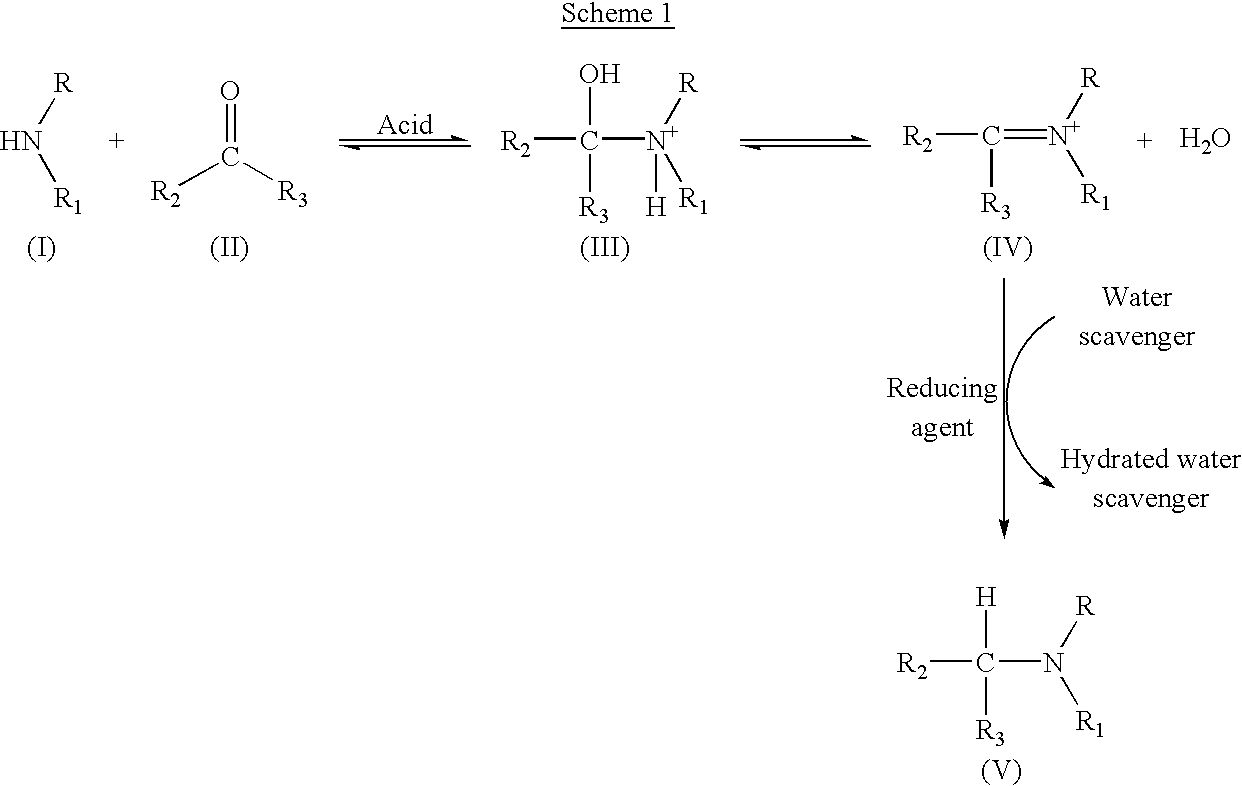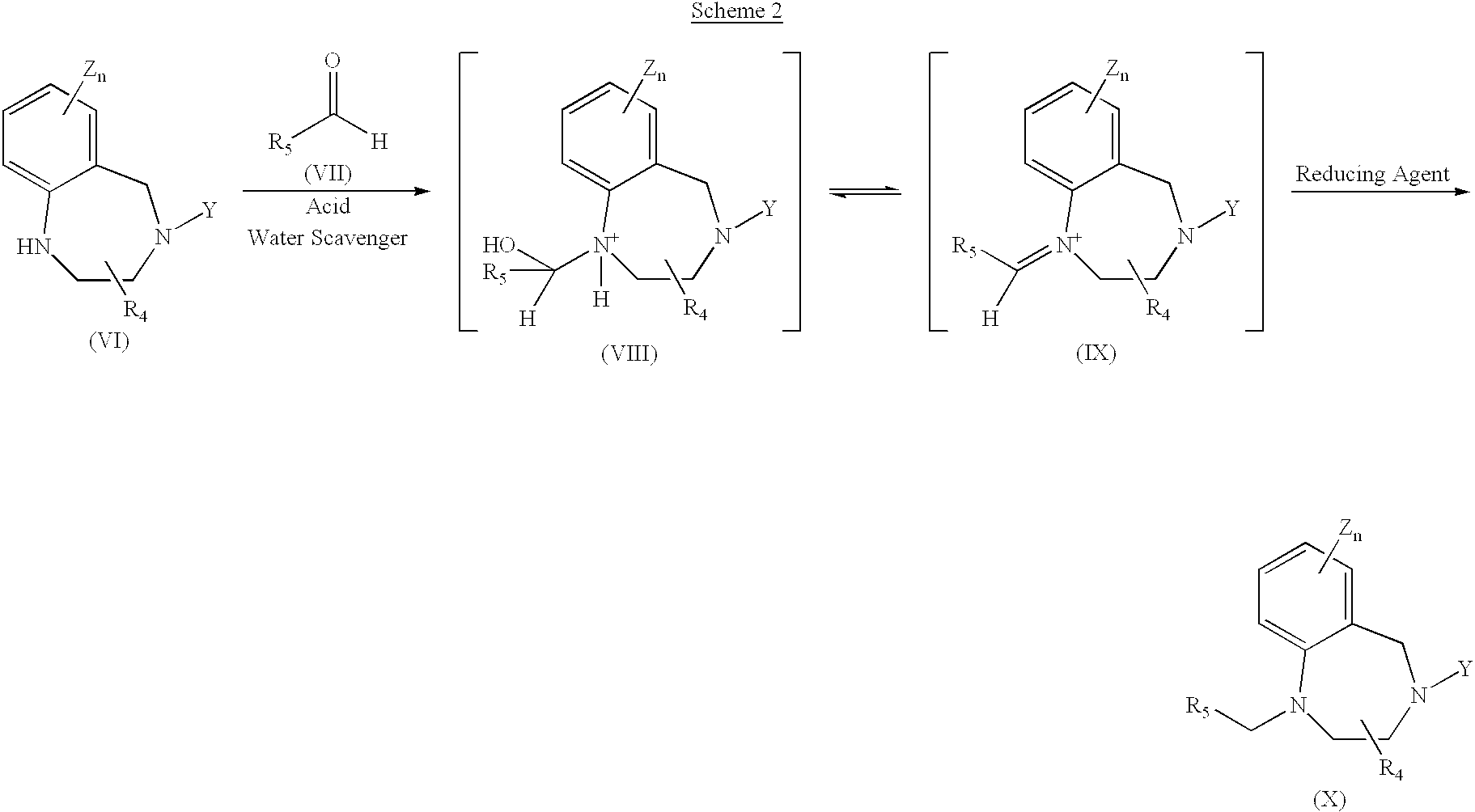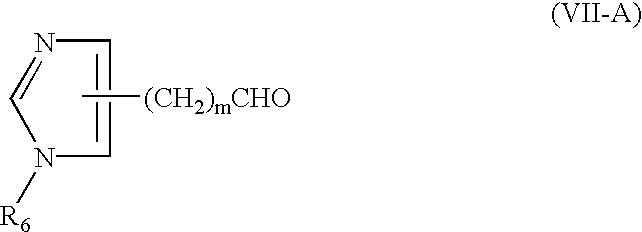Production of tertiary amines by reductive amination
a technology of tertiary amines and amination, which is applied in the field of improved process for the production of tertiary amines by reductive amination, can solve the problems of high toxicity, poor selectivity of hsub>2, pt, pd, or ni, and the number of other reducible groups that could be affected by, etc., to achieve the effect of improving the overall cycle time and cost of operation, improving the efficiency of the use of rea
- Summary
- Abstract
- Description
- Claims
- Application Information
AI Technical Summary
Benefits of technology
Problems solved by technology
Method used
Image
Examples
example i
Preparation of (R)-2,3,4,5-tetrahydro-1-(1H-imidazol-4-ylmethyl)-3-(phenylmethyl)-4-(2-thienylsulfonyl)-1H-1,4-benzodiazepine-7-carbonitrile, X
[0079](R)-2,3,4,5-tetrahydro-3-(phenylmethyl)-4-(2-thienylsulfonyl)-1H- 1,4-benzodiazepine-7-carbonitrile (10 g) and imidazole-4-carboxaldehyde (2.6 g) were mixed in toluene (20 mL) at 20 to 25° C. To this stirred slurry, first trifluoroacetic acid (9.4 mL) and then trifluoroacetic acid anhydride (5.2 mL) were added sequentially while maintaining the temperature below 30° C. The biphasic mixture was vigorously stirred at 20 to 25° C. for 2 hours. Triethylsilane was then added and the reaction mixture was stirred at 20 to 25° C. until the reaction was determined to be complete according to HPLC assay. The reaction mixture was polish-filtered, e.g., through filter paper or a celite bed. The solvent was removed by evaporation, and a viscous yellow oil containing approximately 100% yield of the crude title product was collected.
example ii
Preparation of (R)-2,3,4,5-tetrahydro-1-(1H-imidazol-4-ylmethyl)-3-(phenylmethyl)-4-(2-thienylsulfonyl)-1H-1,4-benzodiazepine-7-carbonitrile, mesylate salt
[0080]The product of Example I was dissolved in anhydrous ethanol. The solution was heated to 60° C. Methanesulfonic acid was added at this temperature and a white slurry formed. The slurry was cooled to 0 to 5° C. over 1 hour and stirred for an additional 1 hour. The resulting white crystalline solid was filtered and washed with cold anhydrous ethanol. The wet cake was dried in a vacuum oven at 70° C. until the loss on drying (LOD) was 99). Typical yield is between about 92% to about 97%.
example iii
Preparation of (R)-2,3,4,5-tetrahydro-1-(1H-imidazol-4-ylmethyl)-3-(phenylmethyl)-4-(2-thienylsulfonyl)-1H-1,4-benzodiazepine-7-carbonitrile, X
[0081]In a 500 mL flask was charged (R)-2,3,4,5-tetrahydro-3-(phenylmethyl)-4-(2-thienylsulfonyl)-1H-1,4-benzodiazepine-7-carbonitrile (25.0 g, 1 eq.), imidazole-4-carboxaldehyde (6.45 g, 1.1 eq.), and CH2Cl2 (150 mL) at room temperature. Cool to 0-5° C. Add trifluoroacetic acid (18.8 mL, 4 eq.) in a period of 10 min. A solution was obtained after addition. Stir the mixture for 10 min at 2° C. Add trichloroacetic acid anhydride (11.7 mL, 1.05 eq.) in a period of 20 min at 2° C. Stir the mixture for 30 min at 0-5° C. Add Na(OAc)3BH (15.51 g, 1.2 eq.) in two portions at 0-5° C. Agitate the mixture at 0° C. for 1.5 h, then room temperature for 1 hour. Add CH2Cl2 (100 mL), then cool to 0° C. Adjust the pH to 8-9 with 10% NaOH (about 125 mL used). Stir for 30 min. Separate the two phases. Wash the organic phase with H2O (2×100 mL), then separate t...
PUM
| Property | Measurement | Unit |
|---|---|---|
| pKa | aaaaa | aaaaa |
| temperature | aaaaa | aaaaa |
| temperature | aaaaa | aaaaa |
Abstract
Description
Claims
Application Information
 Login to View More
Login to View More - R&D
- Intellectual Property
- Life Sciences
- Materials
- Tech Scout
- Unparalleled Data Quality
- Higher Quality Content
- 60% Fewer Hallucinations
Browse by: Latest US Patents, China's latest patents, Technical Efficacy Thesaurus, Application Domain, Technology Topic, Popular Technical Reports.
© 2025 PatSnap. All rights reserved.Legal|Privacy policy|Modern Slavery Act Transparency Statement|Sitemap|About US| Contact US: help@patsnap.com



